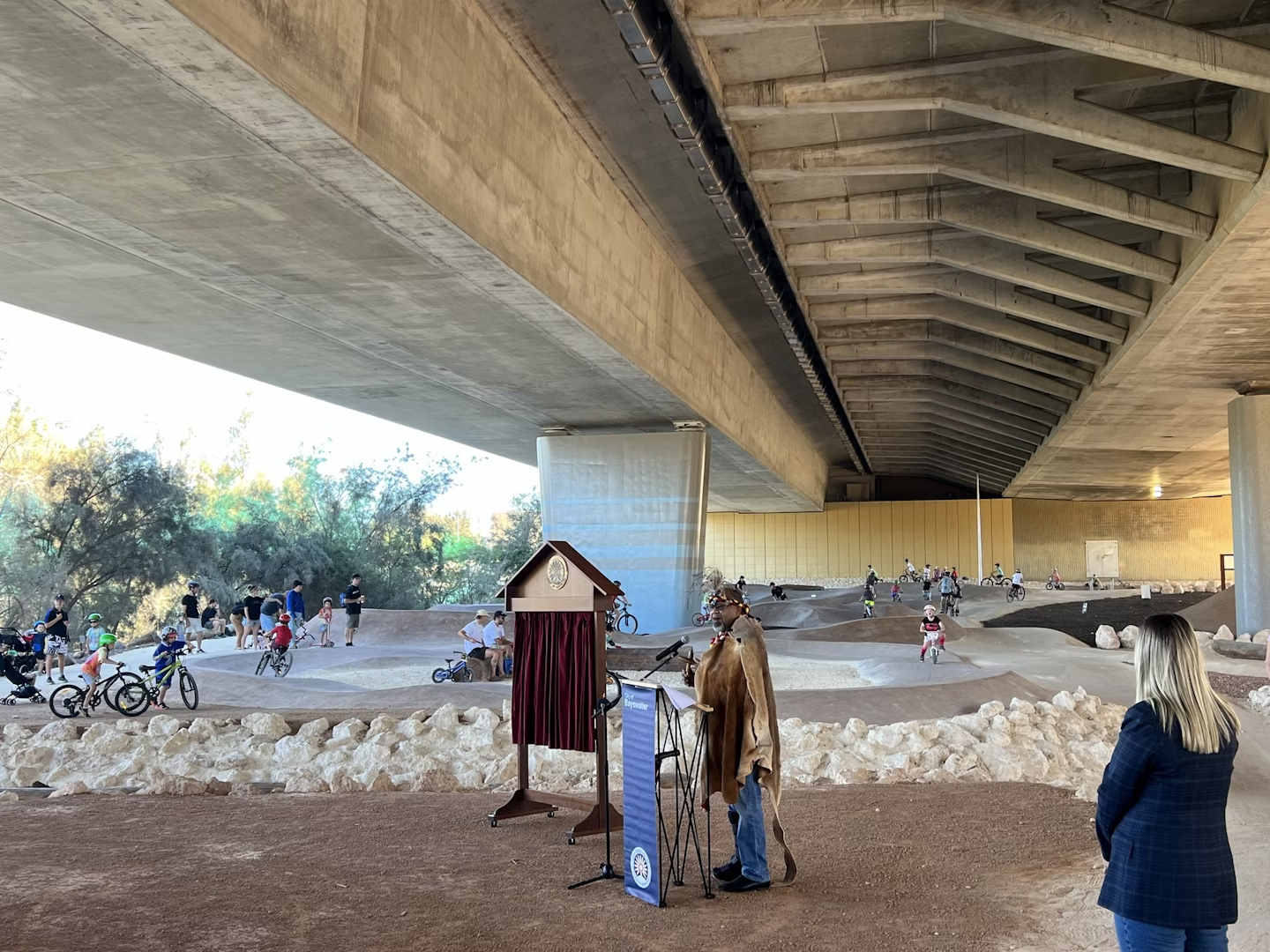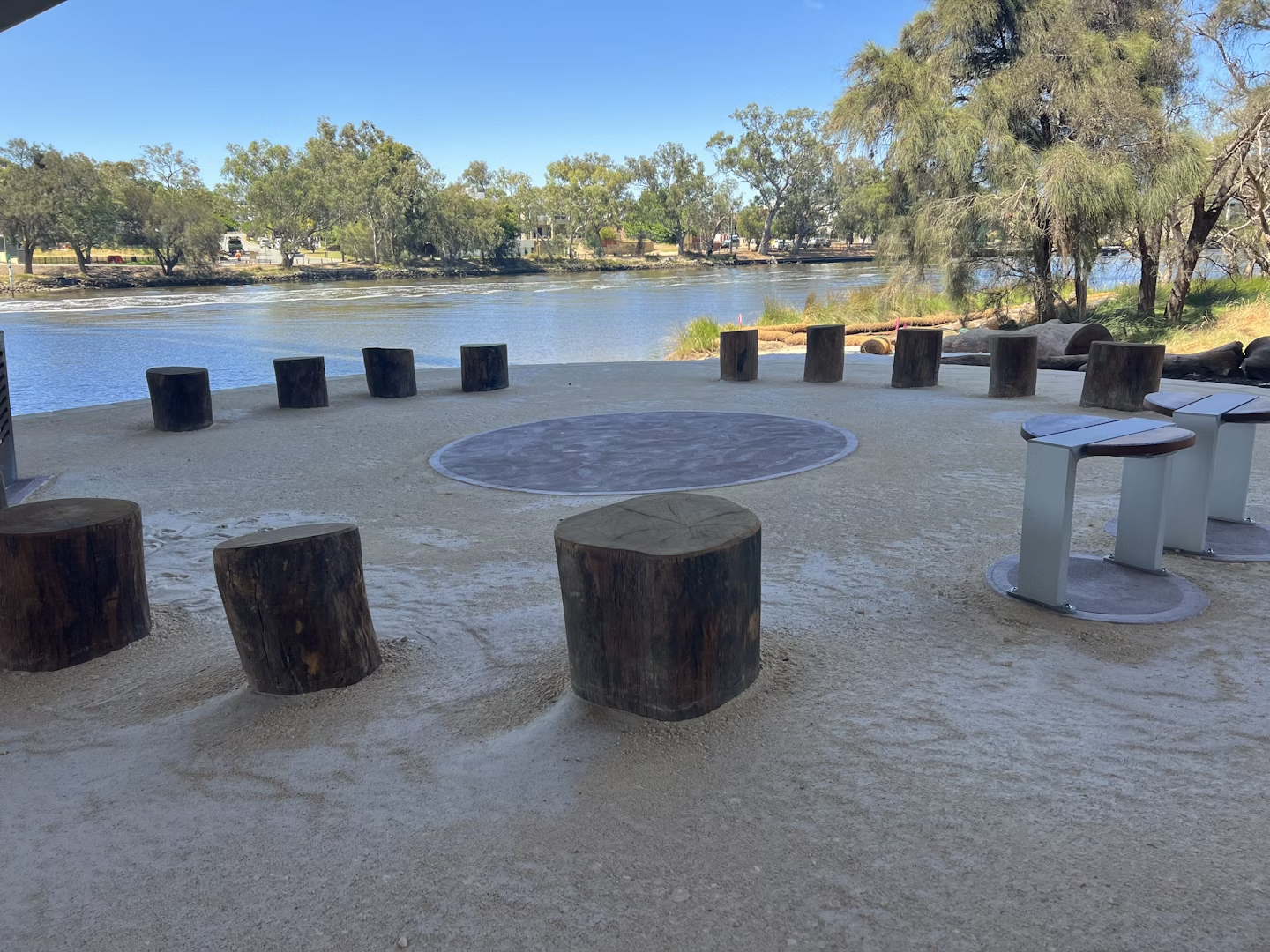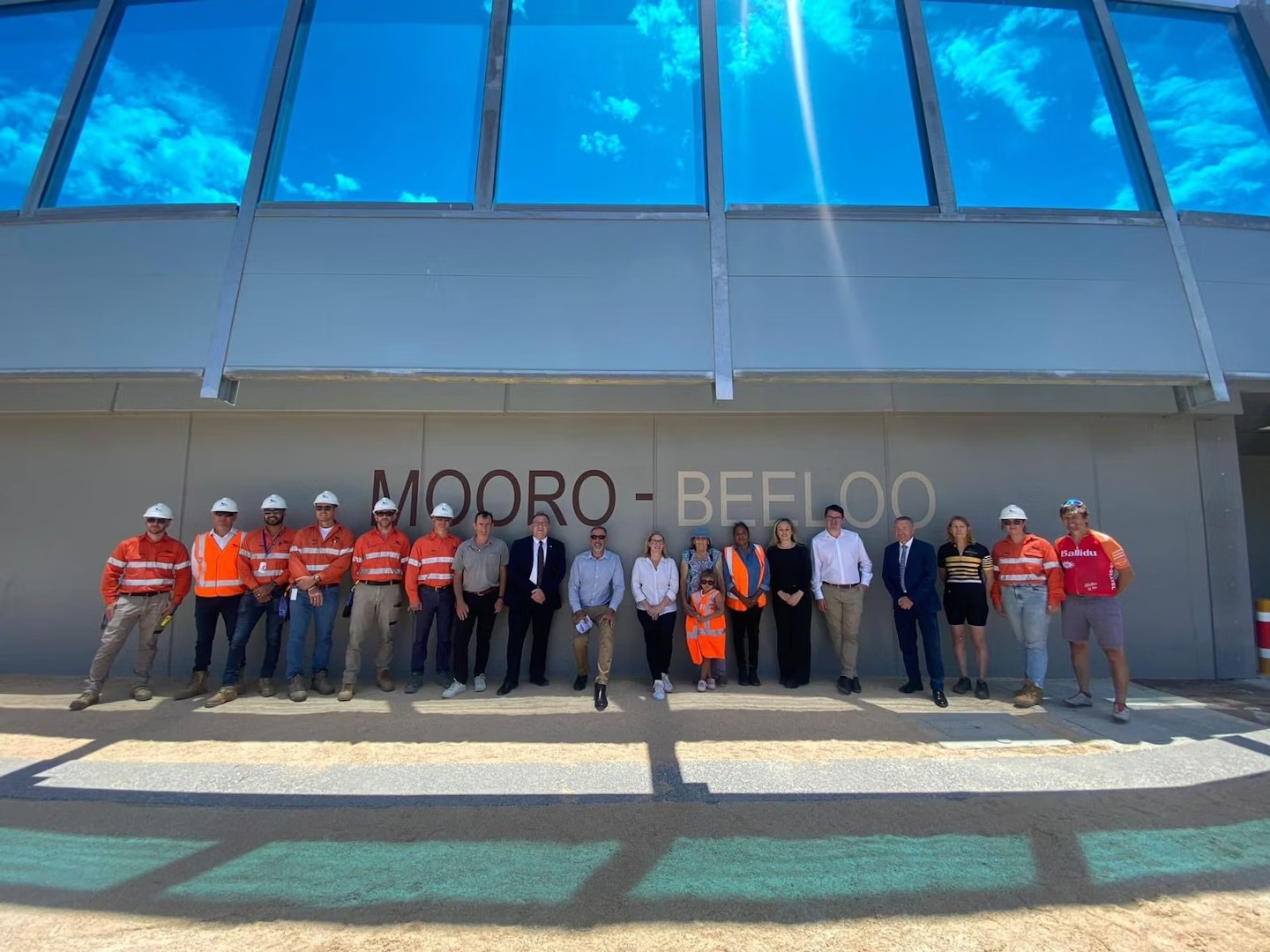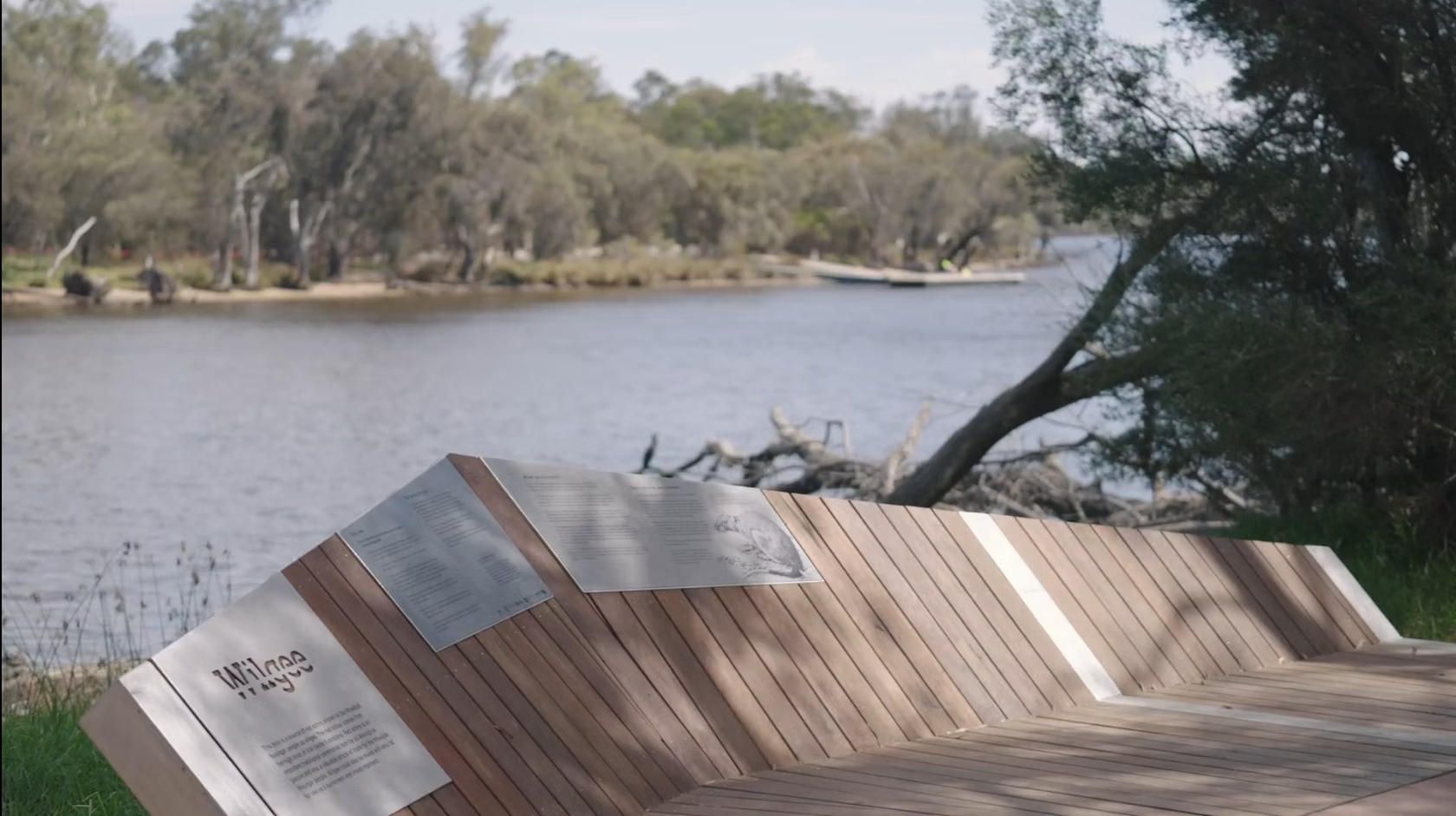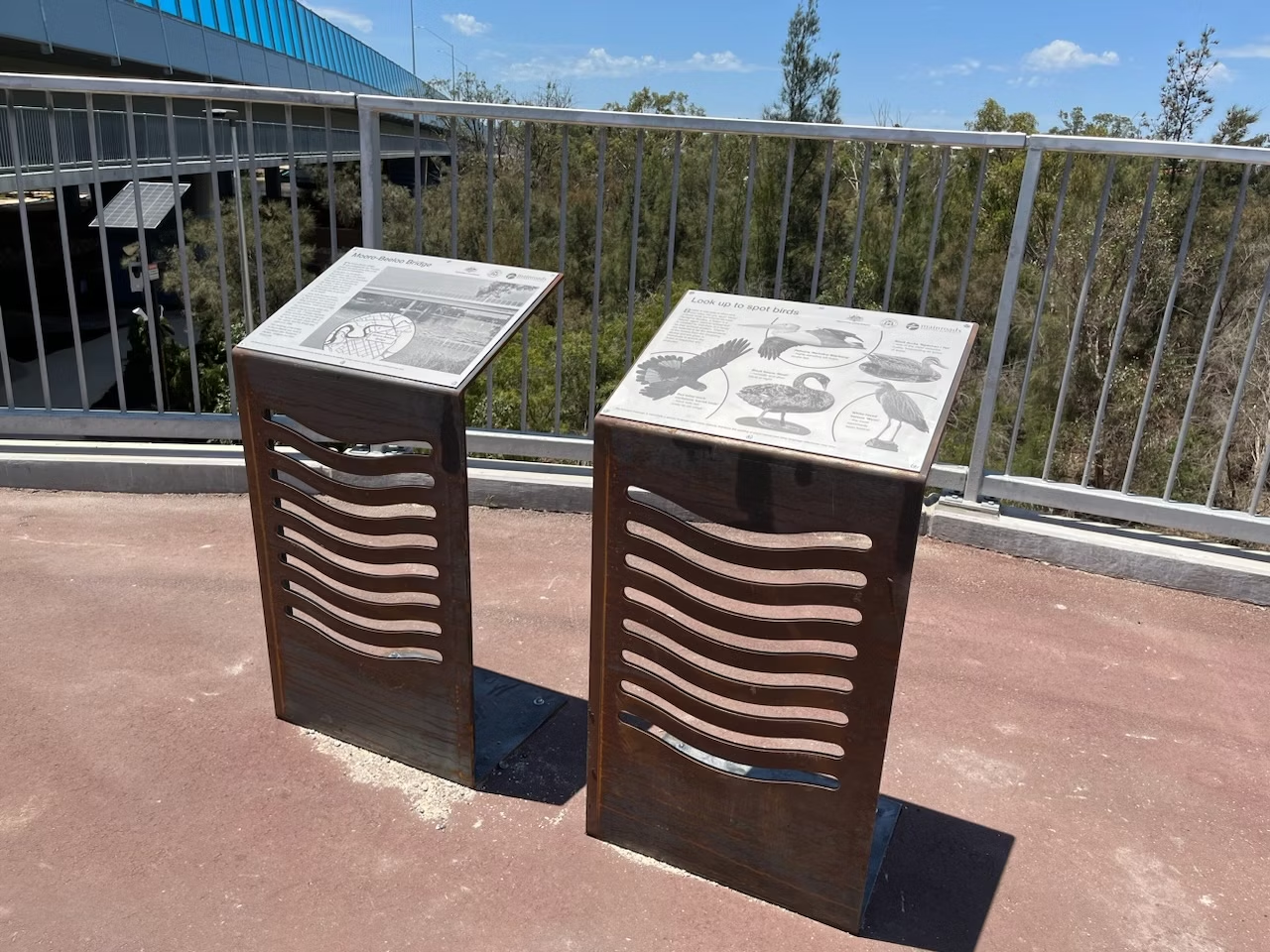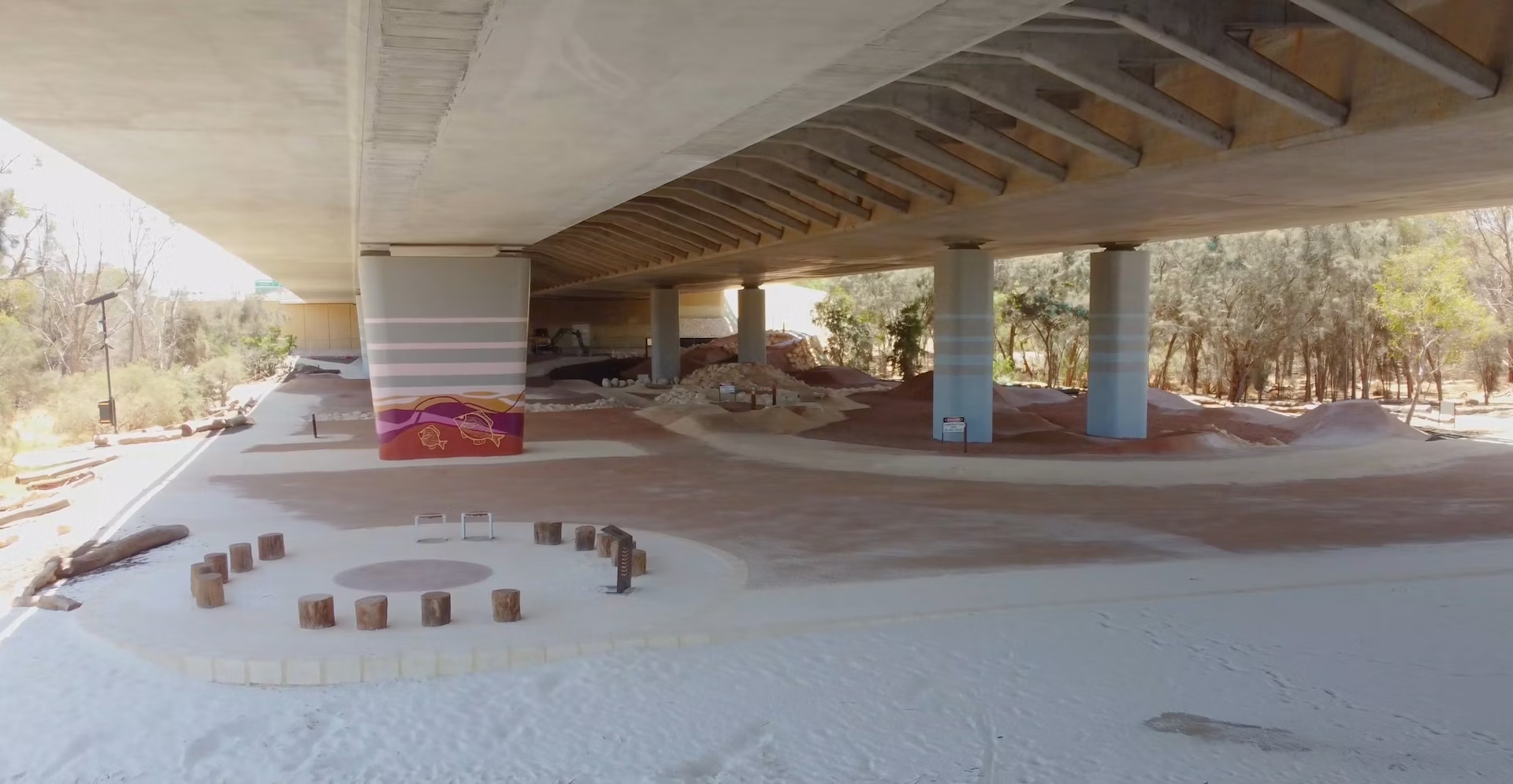Tonkin Gap Project and Associated Works – Social Outcomes
The Tonkin Gap Alliance has delivered a transformative project and successfully revitalised the underutilised area beneath the Mooro-Beeloo Bridge into a dynamic community space. This initiative, along with the integrated heritage trail, prioritises broad social, cultural and environmental benefits, with robust community and stakeholder engagement processes driving the design and execution.
Through extensive collaboration with the local community, Traditional Owners and other key stakeholders, the team have successfully integrated cultural recognition, recreational amenities and environmental enhancement. The key features of this initiative include:
• Mountain bike pump and skills tracks
• Renaming of Redcliffe Bridge to Mooro-Beeloo Bridge
• Interpretive heritage node and signage
• Yarning circle and artwork
• Extensive revegetation and Whadjuk planting
This project leaves behind a lasting legacy for the local community that enhances social infrastructure and amenity, ensuring a space that will be appreciated for generations to come.
Describe WHAT you have done and HOW you have done it. Please provide a summary of your initiative, innovation, or approach.
We are proud to present our award submission, emphasising our achievements in social sustainability and dedication to fostering a positive legacy within the local community.
Our initiative is the reactivation of the once barren, anti-social area under the Mooro-Beeloo (Redcliffe) Bridge, adjacent to the Swan River (Derbarl Yerrigan) in Bayswater, to a thriving family-friendly and vibrant recreation and leisure space. This success-story involved extensive community consultation and Local Government involvement to develop a design that delivers on social, Aboriginal heritage and environmental outcomes. Elements incorporated are detailed in the following section, including a tie into heritage trail aspects.
The Tonkin Gap Alliance (TGA), a partnership comprising Main Roads, Public Transport Authority (PTA), Georgiou, BMD, WA Limestone, BG&E, and GHD, delivered this initiative as part of the Tonkin Gap Project and Associated Works, which comprised of significant upgrades to Tonkin Highway in Western Australia. The project involved constructing additional lanes, new interchanges and bridges, Principle Shared Paths (PSP) and shared paths, while delivering enabling works for METRONET’s Morley-Ellenbrook Line.
Our vision for activating the space was clear; we wanted to acknowledge and enhance the social and cultural value of the local area, thereby leaving a lasting, positive impact on the community. To achieve this, we knew the community’s input was critical.
Our community and stakeholder consultation was extensive - we identified three key stakeholder groups:
• The local community
• Traditional Owners
• The Local Government Authority – City of Bayswater and City of Belmont
We implemented three different stages of local community engagement, using a variety of channels, including open-house events, Facebook polls, surveys, working groups, and targeted consultations. Through this strategic approach we worked with our stakeholders to understand their priorities, values and aspirations for the area.
By engaging the Traditional Owners of the land, we recognised the opportunity to incorporate Aboriginal artwork, Whadjuk planting and a yarning circle. In addition, we included an interpretive Aboriginal heritage trail with informative signs along the Principal Shared Path. These signs are also included under the Mooro-Beeloo bridge as part of the community space.
On the southern side of the river, in partnership with the Department of Biodiversity and Attractions (DBCA) and City of Belmont, we have established an interpretation node near the bridge which forms part of the River Journeys’ program. For this node, we conducted heritage surveys, and two sites of Aboriginal cultural significance were identified within the area which are preserved and recognised in the design.
We also gained valuable insight into the history and stories of the land to help drive the cultural context for the design. We enlisted anthropologist Dr. Edward McDonald to work alongside the Traditional Owners, gathering stories that are unique to the project context and reflective of local Aboriginal values and history. This collaboration ensured that the underbridge design and heritage trail is a true representation of the local culture and history.
In addition, the stories from the cultural report assisted Aboriginal artists with theming for 4 artwork pieces along the heritage trail and under the Mooro-Beeloo bridge.
What were the OUTCOMES and how were those outcomes shared?
The key outcomes achieved from the reactivation area and heritage trail included recreational amenities for community, renaming of Redcliffe Bridge, interpretative heritage node, Aboriginal artwork, Yarning circle, Whadjuk planting and environmental benefits.
These initiatives were diligently designed and executed, resulting in a range of outcomes that serves the local community in recreational enhancement and respects the cultural significance of the area, as detailed below.
Recreational amenities:
A key feature is the mountain bike pump track and skills track, promoting physical activity and social engagement for all age groups. A canoe landing and beach area along the river foreshore offers enhanced access for recreational users. Additional features include seating logs and benches.
Bridge renaming:
TGA constructed a new bridge over the Derbarl Yerrigan, adjacent the existing bridge, incorporating the PSP along the western side. A workshop was coordinated by TGA, Landgate, and the Traditional Owners to determine an appropriate new name for the bridge. The name Mooro-Beeloo was chosen, which acknowledges the two Aboriginal clans who lived on either side of the river before colonisation. Using both names was seen as a fitting acknowledgment of both communities, linked by the bridge.
Interpretive node:
The interpretive node on the southern riverbank includes a new boardwalk space, seating area and signage to highlight the scar tree as a registered heritage site. The signage features local stories related to the marine life found in the Derbarl Yerrigan and their importance in Noongar history. Also featured is the importance of red ochre, known as Wilgee, as holding significant traditional ceremonial value for Aboriginal people and as a valuable trade article for the Whadjuk Noongar people. The interpretive node is intended to educate visitors and honour the history of Aboriginal people in the local community.
Artwork:
The trail includes various artworks and interpretive elements that feature the cultural narrative of the area. Artwork incorporated in three pedestrian underpasses across the project, as well as a bridge pier under the bridge, depict stories from local Aboriginal history and culture. Additionally, interpretive signage at lookout locations on the northern and southern sides of the bridge incorporate traditional stories of local birds, the Waugal (a significant spiritual being in Noongar culture), and the ‘Bidi’ (pathways).
Yarning circle:
In the underbridge area, a traditional yarning circle has been incorporated. Signage details the significance of yarning circles as dedicated spaces for talking, sharing, and building respectful relationships in Aboriginal culture. Constructed using logs collected during clearing in the area, this space provides a tangible representation of the project’s commitment to fostering community dialogue and cultural respect.
Whadjuk planting:
A Whadjuk planting response has been incorporated into the underbridge area. This involved selection of native plant species in consultation with Traditional Owners and installing interpretive signage providing insight into the significance of these species for local Aboriginal people, whether as sources of food or medicine. This not only enhances the local biodiversity but also educates the community about traditional uses of these plants.
Environmental benefits:
Extensive revegetation efforts, including riparian and infill planting, have been implemented alongside improved natural drainage using swales, logs and rocks. These environmental enhancements contribute to the area’s ecological health.
Sharing outcomes:
The outcomes associated with these initiatives were shared with the key stakeholder groups and wider community through various channels. Regular updates were provided throughout the consultation and construction via Facebook, website updates, meetings, and direct communications with key stakeholders and community members. The opening of the area was also shared via TV news reports, Facebook and through construction updates.
An opening community event of the underbridge activation area, held in collaboration with the City of Bayswater in April 2024, officially shared the final outcome of the space to the community. This event featured free bike activities, rider demonstrations, a sausage sizzle, and prizes, drawing considerable community participation and fostering a sense of collective celebration.
The signage incorporated throughout the foreshore area and along the heritage trail offers a long-term opportunity to share stories of local Aboriginal people and their reflections within the design aspects. This ensures that the cultural and historical narratives are continuously communicated to visitors, contributing to ongoing appreciation and understanding of the local heritage values and knowledge.
Describe WHO benefited from your initiative, innovation, or approach?
The wider community, Local Government Areas, Traditional Owners and Aboriginal community, DBCA, visitors and local residents are continuing to benefit from the revitalisation of the underbridge space and heritage trail.
Local community: Enhanced recreational opportunities on their doorstep. Families can ride, walk or drive to the area and spend the afternoon in an outdoor space where they know the whole family are safe, enjoying the amenities and learning about the environment and Aboriginal heritage of the area.
Aboriginal community: Key elements of the heritage trail honours and integrates Aboriginal cultural heritage, offers participatory benefits to the Aboriginal community and serves as an educational endeavour for the wider community.
Local Government Areas (City of Bayswater and City of Belmont): The upgrades to Tonkin Highway, along with the reactivation of spaces has strengthened the local governments appeal and functionality, promoting broader social, cultural and economic benefits. The new recreational and cultural amenities, and environmental enhancements have made the area more attractive to residents and visitors, potentially boosting local tourism and economic activity. The project outcomes support the city’s goals of enhancing public spaces and fostering community wellbeing.
DBCA: Alignment with their vision of biodiversity and natural places being valued by the community and conserved for the future.
Tourists/Visitors: A destination to experience and enjoy. The space offers a new place to visit for healthy living and social interaction, either forging new friendships or visiting with friends and family.
Local residents: The upgrades to the underbridge area and path network has enhanced the area for local residents. Additionally, CCTV cameras were installed at the underbridge activation to assist in reducing anti-social behaviour. Feedback to date has been very positive of these upgrades.
Everyone who visits benefits from the extensive revegetation efforts and improvements to natural drainage has enhanced the environmental value of the area. The interpretive signage integrated as part of the trail and foreshore area provide educational benefits, fostering a deeper appreciation for local biodiversity, traditional ecological knowledge and natural heritage.
The recreational space provides all visitors the opportunity for physical activity, promoting community health and cohesion.
The bridge renaming acknowledges the two Noongar groups historically connected to the area, fostering a sense of inclusion and validating the cultural and historical significance of the Aboriginal community. The initiative educates the public about traditional knowledge while Aboriginal engagement and interpretation has ensured that the voices and values of Traditional Owners were respectively represented.
What LEGACY and UN SDG CONTRIBUTION was achieved?
This initiative created a lasting legacy that aligns and contributes to several UN SDGs, particularly SDG 3, SDG 9, SDG 11 and SDG 17. The initiative achieved enhancement of cultural recognition, environmental sustainability and community engagement.
SDG 3: Good Health and Wellbeing
The initiative has made contributions to SDG 3 by enhancing the health and wellbeing of the local community through the development of new recreational and leisure facilities. The mountain bike pump track and skills track, and canoe landing area, alongside the upgraded PSP connections, encourages physical activity which is essential for maintaining good health. These facilities provide residents with opportunities for exercise, leisure and outdoor activities, promoting an active lifestyle and contributing to overall physical and mental wellbeing. Additionally, the creation of inviting public spaces such as seating areas and the yarning circle fosters social interaction and community engagement. These spaces serve as gathering points for residents of all ages, encouraging social participation and strengthening community bonds. The yarning circle in particular highlights the cultural practice of sharing and building relationships, further contributing to public health outcomes and inclusivity.
Goal 9: Industry, Innovation and Infrastructure
The initiative has contributed to SDG 9 by enhancing critical infrastructure, with the inclusion of the Mooro-Beeloo Bridge, which improves vehicle and cyclist/pedestrian transportation connectivity. TGA embraced innovation with its collaborative approach, particularly in integrating cultural and environmental considerations into the design. The outcomes described throughout this submission demonstrates a commitment to building infrastructure that is resilient and inclusive.
Goal 11: Sustainable Cities and Communities
SDG 11 aims to make cities inclusive, safe, resilient and sustainable. Numerous elements of the initiative have contributed to the sustainability and liveability of the Bayswater area. One of the key elements of this was the extensive revegetation effort, including riparian, infill and Whadjuk planting, which has improved ecosystem health of the previously sparse area. The use of natural drainage solutions has enhanced the water management and reduced risk of flooding, contributing to resilience of the foreshore area to erosion and scouring. These environmental contributions support biodiversity and create a more pleasant environment for the community.
The integration and expansion of the PSP network improves accessible and sustainable transport network systems, encouraging active transport and improving connectivity between the north and south of the wider metropolitan area.
The cultural and educational aspects such as the interpretive node and signage along the heritage trail, enrich the community’s connection to its cultural history and environment. By acknowledging and incorporating stories from local Whadjuk people, alongside the renaming of the bridge to Mooro-Beeloo, the project has created a space that respects and celebrates local heritage.
Goal 17: Partnerships for the Goals
The success of the initiative is rooted in its collaborative approach, emphasizing the importance of partnerships in achieving SDG 17. The project bought together a broad and diverse range of stakeholders in consultation towards the design development. This partnership approach was demonstrated through the comprehensive engagement program, where input from the local community and City of Bayswater shaped the environmental and social design elements and implementation of the foreshore reactivation.
The collaborative workshops and consultation with Traditional Owners ensured appropriate and comprehensive integration of heritage values, while involvement of local Aboriginal artists in developing the heritage trail and foreshore artwork ensured that all cultural elements were authentic and representative of the local area.
Regular updates through Facebook, construction updates and the official opening event further exemplified the projects commitment to transparency and community involvement. Once completed, the community’s opening celebration played a key role in fostering a sense of ownership and pride among community members.


